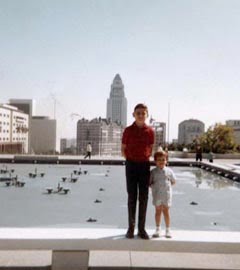 photo courtesy of http://www.you-are-here.com
photo courtesy of http://www.you-are-here.comGoogie Architecture: A form of futuristic atomic architecture that originated in Southern California in the early 1940s. Although biased with restaurants and coffee shops and spurred by California car culture, its style can be seen in many other forms including motels, bowling alleys, liquor stores, car washes and casinos.
In a rare field assignment for my job today, I boarded the 740 bus at Union Station and traveled to the end of the line at 182nd street and Hawthorne. Once we past the Broadway Theatre district and Exposition Park, we ventured into a series of Los Angeles neighborhoods that I have rarely, if ever have visited in my 46 years in Los Angeles. Neighborhoods such as Arlington Park, Leimert Park, Crenshaw Manor, Angles Mesa, Hyde Park, and The Crenshaw District. Of note on my trip was the cornerstone of the Crenshaw District, the 1947 Baldwin Hills Crenshaw Plaza with its shades of art deco architecture. Also of interest was Leimert Park, a famous jazz and literary community that hosts many events each year to promote music, literature and the arts. Leimert Park was featured in the Michael Mann film Collateral and was also the neighborhood where the body of Elizabeth Short was found, in the now famous and still unsolved Black Dahlia Murder case of 1947.
The jewel of this trip occurred as we traveled south down Hawthorne Blvd and approached 120th street. Through the hazy windows of the bus, an image appeared in the form of an original Chips Coffee Shop. This magnificent example of Googie Architecture stood in an almost undisturbed state as it has since its maiden pot of coffee was brewed 53 years ago. Built in 1957 by Mr. Harry Harrison, an architect who later worked with famed modernist architect Richard Neutra, it has somehow been saved by the Googie Gods and not rendered into a commercial strip mall eyesore. With its three distinct pylons and its mesh background floating the letters
The jewel of this trip occurred as we traveled south down Hawthorne Blvd and approached 120th street. Through the hazy windows of the bus, an image appeared in the form of an original Chips Coffee Shop. This magnificent example of Googie Architecture stood in an almost undisturbed state as it has since its maiden pot of coffee was brewed 53 years ago. Built in 1957 by Mr. Harry Harrison, an architect who later worked with famed modernist architect Richard Neutra, it has somehow been saved by the Googie Gods and not rendered into a commercial strip mall eyesore. With its three distinct pylons and its mesh background floating the letters
"C h i p s", it called out my name but I could not jump out of a moving bus to capture its atomic green façade on film. In the interim, I have posted a photo and given full credit to its owner, but soon I will be traveling to Hawthorne to enter the time capsule of the Chips Coffee Shop.
*
For an interesting read on Googie Architecture pick up a copy of GOOGIE REDUX by Alan Hess.
For an interesting read on Googie Architecture pick up a copy of GOOGIE REDUX by Alan Hess.

No comments:
Post a Comment